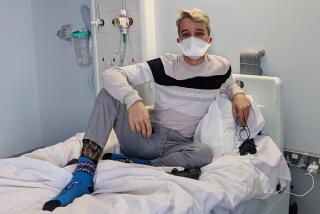Volunteers in Weightless Study : 11 Spend a Month in Bed for NASA
- Share via
MOUNTAIN VIEW, Calif. — Russell Nelson got out of bed on Sunday for the first time in 30 days. But the 44-year-old San Jose graphic artist had not been sick.
He was one of 11 volunteers who had spent all of August in bed at the Ames Research Center here to help National Aeronautics and Space Administration scientists learn more about the effects of prolonged weightlessness on the human body.
Nelson and the others were not in a weightless environment. Rather, they spent the month lying in bed with their feet about 12 inches higher than their heads--the nearest thing to weightlessness, experts said. That position makes blood pool in the chest and head, and the enforced inactivity allows leg muscles to wither--effects that appear within a few days in the weightless environment of space.
For 30 days, the 11 men watched television, played games, played cards, took showers, read books, and had water-gun fights with the nurses--while never once sitting up. And when the bed-rest test ended Sunday, all but three were as weak as astronauts returning from space.
The lucky three each had the muscles in one leg stimulated intermittently with electrical current about equal to that produced by a nine-volt battery in an experimental effort to try to keep the muscles from weakening. “It didn’t hurt, it just felt kind of fuzzy,” said volunteer Lance T. Hinkley, a 30-year-old hospital technician from Hillsborough.
The experiment was apparently a success. “One leg felt like a wet noodle and the other like the Incredible Hulk,” Hinkley said at a Monday press conference.
The discovery could have profound implications for maintaining the health of U.S. astronauts, who someday might spend up to six months in space. The electrical stimulator might be used in conjunction with conventional exercise to keep their bodies in much better shape, said physiologist Victor A. Convertino of NASA’s Kennedy Space Center.
Attempting to Stop It
NASA has been conducting bed-rest studies on men and women here every year since 1976, but most have lasted only one or two weeks because most U.S. space flights have lasted less than a week. Scientists in the Soviet Union have conducted tests for as long as a year, “but they have not been very good about sharing their data with us,” said endocrinologist Joan Vernikos-Danellis, who headed the study.
“We want to find out what happens to the heart and blood vessels, why astronauts feel faint upon re-entry, which muscles atrophy and why,” she said.
If scientists can get a better understanding of what causes the body to deteriorate in weightlessness, she said, “then perhaps we can find ways to minimize or stop it.”
That research also may have applications on Earth. “The fact that you get people up out of bed quickly after surgery to speed their recovery stems from our work,” she said. ‘
The electric stimulator might also be used to maintain muscle tone in invalids and others who are bedridden, Convertino said.
This year’s group was composed of men between the ages of 30 and 50 who responded to newspaper and radio ads promising the chance to earn a little money--about $2,700--and help the space program.
“I had a lot of vacation time saved up and this seemed a lot more restful than going to Hawaii,” Hinkley said. “Besides, I wanted to prove I could do it.”
“And they are all hooked on space,” Danellis added. In fact, science-fiction books were piled high in the windowless, hospital-like wards where the men stayed, two to four per room. And science-fiction movies were popular fare on the color televisions hanging over each bed.
No visitors were allowed, but the men could phone out. They were not allowed to rise at all. They even had a special roll-through shower, dubbed the “car wash,” where they could get clean lying on tilted gurneys.
The volunteers ate normal food, except that salt and potassium were limited in order to reduce blood pressure. That meant no potatoes, tomatoes, potato chips, bananas and bacon. Most of the volunteers lost about 10 pounds.
Exercise in Bed
Some of the patients were required to exercise their legs in bed--such as doing leg lifts. “But we’ve generally found that exercise has not been really effective,” Convertino said. The men lost 25% to 30% of the strength in their legs whether they exercised or not.
That is why Convertino is enthusiastic about electrical muscle stimulation. Tests on animals and on humans in casts have shown that the stimulation can prevent muscles from withering, he said. “But we’ve never had any good numbers about how large the effect is.”






